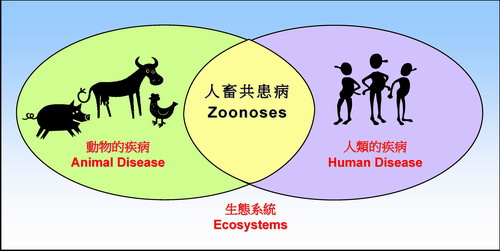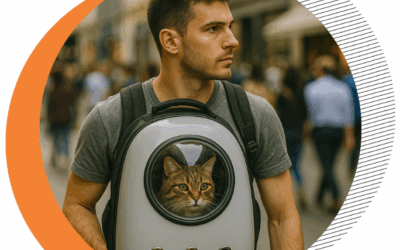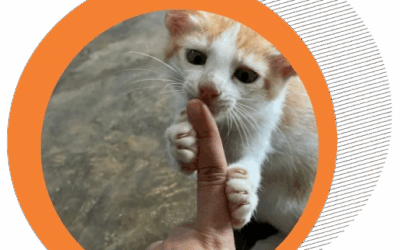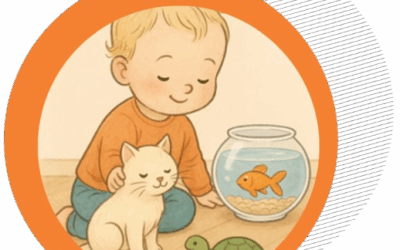
Zoonoses in the Food Chain.
By: Putu Eka Gunadi
Zoonoses originate from pathogens such as viruses, bacteria, parasites, or prions that can be transmitted from animals to humans. Some well-known examples of zoonotic diseases are rabies, bird flu, anthrax, and salmonellosis. These diseases are often hidden in food supply chains, posing a serious threat to human health. Zoonoses can be transmitted in a variety of ways, including through animal bites, direct contact with infected animals, or the consumption of contaminated animal products.

Image 1. Zoonotic transmission diagram (Source: www.cfs.gov.hk)
The spread of zoonoses through the food supply chain can pose a threat to human health. Animal products such as meat, milk and eggs can be a medium for zoonotic pathogens if not handled properly.
Some examples of zoonotic transmission through food include:
1. Salmonellosis: This disease is caused by Salmonella bacteria which can be found in raw meat, eggs and unpasteurized dairy products. Consuming food contaminated with Salmonella can cause symptoms such as diarrhea, fever and stomach cramps.
2. E. coli: Certain Escherichia coli bacteria, especially the E. coli O157 strain, can cause serious illness in humans. This bacteria is often found in poorly cooked beef, raw milk, and vegetables contaminated by animal feces
3. Brucellosis: The disease is caused by Brucella bacteria that can be transmitted through the consumption of raw milk or unpasteurized dairy products. Symptoms of brucellosis include fever, night sweats and joint pain.
4. Campylobacter: It is a Gram-negative bacterium that lives in the digestive tract of warm-blooded animals. This bacteria can be found in food of animal origin because it is contaminated with animal feces during food processing.

Image 2. Food ingredients from animal products (Source: /www.foodnavigator-sa.com)
Some types of food of animal origin that have the potential to be a source of zoonotic transmission include:
1. Meat : Food of animal origin such as meat is a perishable food, this is because meat contains nutritional elements that are good enough for the growth of microorganisms, especially bacteria, so that it will have an impact on the shelf life and quality of the final product.
2. Egg: Raw or undercooked eggs can also contain bacteria such as Salmonella, which can cause food poisoning if not cooked properly.
3. Milk/Dairy: Milk, if not properly pasteurized, can be a good medium for disease-causing bacteria, viruses and parasites such as brucellosis, listeriosis and campylobacteriosis to survive and transmit to humans through consumption.
4. Fish : There are several types of zoonotic nematode parasitic diseases that originate from marine fish, one of which is anisakiasis.
The spread of zoonoses through the food supply chain can pose a threat to human health. Animal products such as meat, milk and eggs can be a medium for zoonotic pathogens if not handled properly.
Read Also : Improving Farm Animal Welfare
To reduce the risk of foodborne zoonotic transmission, several preventive measures can be taken:
1. Hygiene and Sanitation: Ensuring hygiene at all stages of food production, from farm to table, is essential. This includes good sanitation practices on farms, hygienic food processing and personal hygiene.
2. Pasteurization: Dairy products must be pasteurized to kill harmful bacteria such as Brucella and Salmonella.

Image 3. Meat cooking process (Source: www. hellosehat.com)
3. Adequate Heating: Cooking animal foods at the right temperature can kill many pathogens. For example, beef must be cooked to an internal temperature of at least 70°C to kill E. coli.
4. Supervision and Regulation: Governments and health regulatory agencies must ensure that food safety standards are strictly implemented and monitored. This includes regular inspections of farms
and food processing facilities, rph surveillance, meat import regulations, etc.
5. Consumer Education: Consumers should be provided with sufficient information on how to safely handle and cook animal products. This education can be done through public health campaigns and labeling on food products.

Image 4. Regulations for imported meat (Source: www.ditjenpkh.pertanian.go.id)
Source:
Related Post :
Not Just a Fashion Statement: Carrying Cats Should Prioritize Welfare, Not Aesthetics
By: drh.Mikeu Paujiah, M.MIn recent years, we have increasingly seen a trend on social media: cats being taken for walks in transparent backpacks that fully expose their bodies to the outside. At first glance, it looks cute, stylish, and adorable. However, when viewed...
More Than Just Style: Ethical Ways to Carry Cats According to Animal Welfare Principles
By : drh. Mikeu Paujiah, M.M.In the era of social media, we often see cats being taken out in transparent backpacks that display their entire bodies to the world. Cute? Perhaps. But is it comfortable and safe for cats? Not necessarily.Cats are highly sensitive beings....
I’m Not Trash: The Story of a Cat Who Was Once Abandoned
I was abandoned. Not because I was naughty. Not because I was sick. But because I was no longer seen as important. A small cardboard box became my last shelter before being thrown to the side of the road. People walked by, some glanced, but none stopped. I stayed...
Build Your Child’s Responsibility Through Pet Care
By: Drh. Mikeu Paujiah, Dipl. MontessoriKeeping a pet is not just about filling leisure time. For children, taking care of a pet can be a powerful way to learn empathy, responsibility, and compassion. However, without proper guidance from parents, this process may be...
Pets Suitable for Children, According to Age!
Find the right pet for your child based on their age. From fish to dogs, check out our child-friendly pet recommendations here!By: Drh. Mikeu Paujiah, Dipl. MontessoriChoosing a pet for your child isn’t just about picking the cutest one. Every animal has its own...
Tips for Traveling with Pets: Journey & Post-Arrival Care
By: drh. Mikeu Paujiah & Maryam SmeerTraveling with your pet? Check out tips for a safe and comfortable journey, plus post-trip care to keep them healthy and happy during the holiday!After making thorough preparations before traveling, it's time to understand how...





